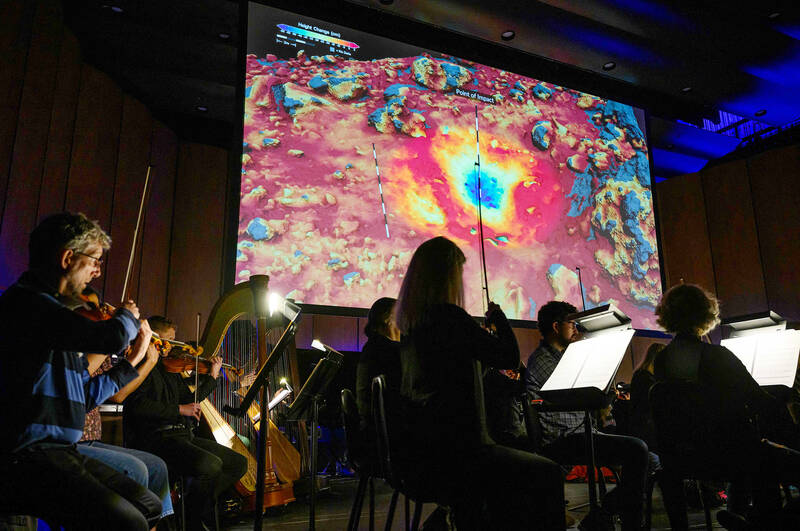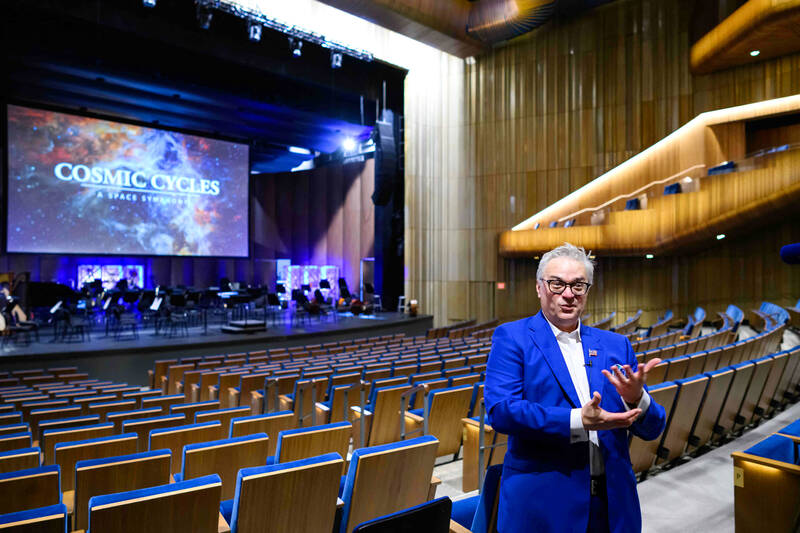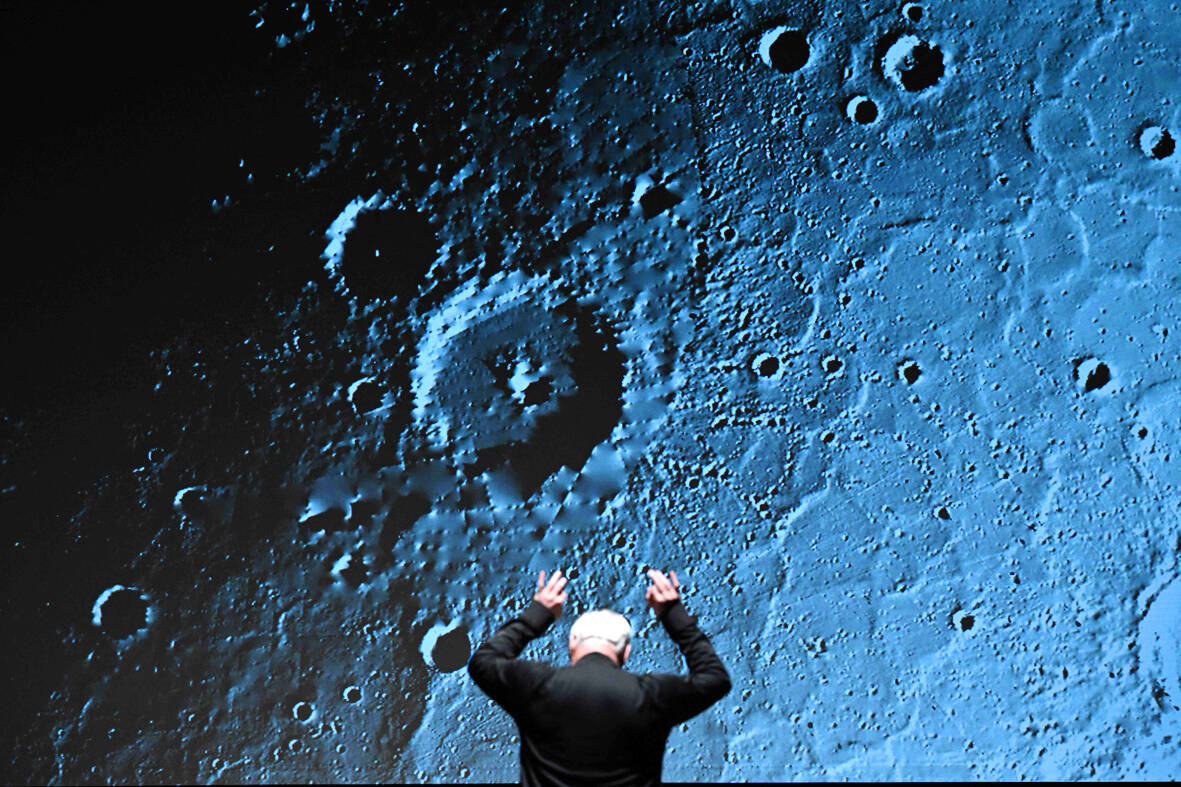It could be the ultimate blend of art and science — a new seven-suite “space symphony” inspired and illustrated by NASA’s latest mind-boggling images.
The world premiere outside Washington last week of Cosmic Cycles showcased vivid imagery compiled by the US space agency alongside the first-ever public performance of the music.
Henry Dehlinger, the symphony’s American composer, describes it as “almost like a total artwork.”

Photo: AFP
“It’s not just music, it’s not just visuals — it’s not a score for a film either,” the 56-year-old told AFP said before the concert.
“It’s more of an immersive experience that encapsulates both visuals and sound.”
A similar effort was undertaken over a century ago by English composer Gustav Holst — but when he wrote his famous ode to The Planets, much in astronomy remained only theoretical.

Photo: AFP
Since then, humans have walked on the Moon, sent roving research labs to Mars and probed across the solar system with powerful telescopes allowing us to peer billions of light-years away.
The images from that research, compiled by NASA producers into seven short films, served as the inspiration for Dehlinger.
“I had to almost pinch myself and remind myself that this isn’t pretend — this is the real deal. Not science fiction, it’s the actual science,” he said.

Photo: AFP
Piotr Gajewski, music director and conductor of the National Philharmonic, explained that the idea for the project came after previous work with NASA on visuals to go with a double-billing of Claude Debussy’s La Mer (“The Sea”) and Holst’s The Planets.
For their next collaboration, 64-year-old Gajewski said he suggested to NASA “that we turn the tables on them.”
“Rather than them getting a piece of music and putting pictures to it, that they start by putting short videos together... of their very, very best work.”
For Wade Sisler, executive producer at NASA’s Goddard Space Flight Center, the challenge was worth the effort.
“It’s a journey unlike one that I have ever helped anyone take,” Sisler, 64, said
‘LIKE VAN GOGH PAINTINGS’
The seven-part piece begins at the heart of our solar system — the Sun — with shots of its swirling and gurgling surface, and explosions of particles out to the planets.
The next two movements focus on NASA studies of our home planet, from a global perspective and then through Earth photographs taken by astronauts in orbit.
Apart from photos and videos, interspersed throughout the seven films are a “mesmerizing collection of data visualizations” created by NASA, Sisler explained.
Data on ocean currents, for example, “look like Van Gogh paintings when you put them in motion. The colors are beautiful, you see patterns that you never realized before.”
A fourth segment on the Moon is followed by profiles of each planet — including a focus on images of the Martian surface taken by NASA rovers.
Jupiter, a “regal subject” according to Dehlinger, is introduced by roaring chimes and horns.
The symphony also takes a detailed look at recent experiments on asteroids before a big finale of nebulae, black holes and other galactic phenomena.
In addition to two performances at venues outside Washington, NASA has released the videos to its YouTube page with a synthesized version of Dehlinger’s soundtrack.
‘A GREAT MYSTERY’
To hammer home the equal importance of the music and video, conductor Gajewski explained, they decided not to aim for exact synchronization, but to be more “fluid.”
That approach allows him “to find some moments that are different each time and each performance.”
“We really wanted people to be able to experience the music, the performers themselves, and also the science in a balanced portfolio,” Sisler added.
Knowing the images and missions were real, Sisler said, elicits a stronger audience response in the digital age, when “you can conjure up anything through AI, conjure up anything in digital effects.”
“People are interested in real results. Like ‘wow, we really went to that asteroid. Wow, we’re really bringing it back here to Earth,’” he said, referring to the daring OSIRIS-REx sample retrieval mission.
That awe-inspiring factor made the images perfect companions to orchestral pieces, Gajewski said.
“What is it that all of a sudden makes us emotionally weak when we hear one kind of music, or proud when we hear different kinds?” he asked.
“It’s all a great mystery, and of course space is the other great mystery, so they complement each other very well.”

The Democratic Progressive Party (DPP), Chinese Nationalist Party (KMT), and the country’s other political groups dare not offend religious groups, says Chen Lih-ming (陳立民), founder of the Taiwan Anti-Religion Alliance (台灣反宗教者聯盟). “It’s the same in other democracies, of course, but because political struggles in Taiwan are extraordinarily fierce, you’ll see candidates visiting several temples each day ahead of elections. That adds impetus to religion here,” says the retired college lecturer. In Japan’s most recent election, the Liberal Democratic Party lost many votes because of its ties to the Unification Church (“the Moonies”). Chen contrasts the progress made by anti-religion movements in

Taiwan doesn’t have a lot of railways, but its network has plenty of history. The government-owned entity that last year became the Taiwan Railway Corp (TRC) has been operating trains since 1891. During the 1895-1945 period of Japanese rule, the colonial government made huge investments in rail infrastructure. The northern port city of Keelung was connected to Kaohsiung in the south. New lines appeared in Pingtung, Yilan and the Hualien-Taitung region. Railway enthusiasts exploring Taiwan will find plenty to amuse themselves. Taipei will soon gain its second rail-themed museum. Elsewhere there’s a number of endearing branch lines and rolling-stock collections, some

This was not supposed to be an election year. The local media is billing it as the “2025 great recall era” (2025大罷免時代) or the “2025 great recall wave” (2025大罷免潮), with many now just shortening it to “great recall.” As of this writing the number of campaigns that have submitted the requisite one percent of eligible voters signatures in legislative districts is 51 — 35 targeting Chinese Nationalist Party (KMT) caucus lawmakers and 16 targeting Democratic Progressive Party (DPP) lawmakers. The pan-green side has more as they started earlier. Many recall campaigns are billing themselves as “Winter Bluebirds” after the “Bluebird Action”

Last week the State Department made several small changes to its Web information on Taiwan. First, it removed a statement saying that the US “does not support Taiwan independence.” The current statement now reads: “We oppose any unilateral changes to the status quo from either side. We expect cross-strait differences to be resolved by peaceful means, free from coercion, in a manner acceptable to the people on both sides of the Strait.” In 2022 the administration of Joe Biden also removed that verbiage, but after a month of pressure from the People’s Republic of China (PRC), reinstated it. The American